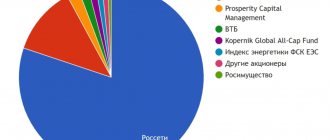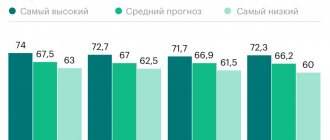Deflation is a process that is completely contrary to inflation. The terminology comes from the Latin word “deflatio” - lowering, deflating.
It is possible to explain what deflation is in a country’s economy in simple words. This is a significant increase in the value of the state currency and a decrease in prices for goods and services.
This process may seem harmless and beneficial to the population, but this is a misconception.
Deflation, what is it?
Deflation is the reverse process of inflation. Lower prices should stimulate the ability to buy new products. In fact, this causes lower wages and greater unemployment. Enterprises go bankrupt because they receive less revenue, cannot cover production costs, or take out loans for development.
Most often, deflation is recorded at the end of a month or quarter. For example, when calculating the price index, an increase for the 1st and 2nd quarter is revealed - 0.3% and 0.5%. In the 3rd and 4th quarters, the price index will decrease by 1% and 1.4%, that is, inflation will occur. The final annual price index will be:
1+1.4-0.3-0.5 = 1.6% (inflation).
In some cases, deflationary processes appear when calculating the index based on the results of a year or several years.
❓ Frequently asked questions
Can deflation be harmless?
For deflation to be harmless, there needs to be an increase in purchasing power along with economic growth and other positive market factors.
Does deflation have any advantages?
No.
⭐ Lawyer. Special correspondent for the site
Didn't find the answer to your question? Call hotline 8. It's free.
Types of deflationary processes
There are four main types of deflation:
- Deflation of bank loans occurs when holders withdraw money from deposits en masse. The banking system is changing, unreliable banks are going bankrupt, and the market value of securities is falling. Debt deflation results in borrowers having to pay back loans with increased debt costs. This benefits creditors, but not debtors
- build-up deflation implies widespread accumulation of currency on hand. The economic situation is deteriorating, citizens stop spending because they do not trust the state
- Growth deflation occurs when demand for a specific product increases. The volume of production of a product increases, and its price falls. This process has both positive and negative impacts on the country’s economy.
- Confiscatory deflation occurs when government agencies seize funds from citizens and businesses. There are fairer methods of mitigating deflation than cash confiscation
The state can use a variety of monetary and tax mechanisms. For example, increase the key banking rate, limit cash flows, withdraw some cash from circulation, increase taxes, reduce the cost of maintaining the state apparatus. At the same time, control over the sphere of currency circulation, foreign trade, and the sale of government securities is being strengthened.
How deflation affected world states
The process of increasing the cost of money is not new; it has accompanied the development of the world economy for many decades. Deflation can be seen at various points in the development of the economy of a number of countries, if you start studying this issue.
During the Great Depression, when the New York Stock Exchange crashed in 1929, many financial institutions went bankrupt and customers lost all their deposits. This circumstance caused an impressive rise in the price of the currency, due to the artificial creation of a “credit bubble” and its inevitable explosion.
Another significant situation occurred in Japan, where in the late 1980s the government artificially increased the demand for real estate, which caused a significant increase in prices. Thus, the land under the imperial palace was worth approximately the same as the entire territory of the American state of California. It was impossible to maintain price increases for a long time, the bubble burst, after which there were numerous cases of bankruptcy of credit institutions and a drop in loan capital. Then the Japanese authorities again tried to carry out this procedure, but credit institutions and industry no longer wanted to participate in the scam. As a result, modern Japan has an extremely low demand for real estate and land, despite the small scale of unoccupied territories, whose value is declining every year.
To summarize, we can note a rather difficult definition of the concept of deflation, which is not so easy to explain in simple words. Obviously, this is a process of increasing the price of a currency, created artificially (by removing a certain amount of money from circulation) or naturally, by increasing the volume of production of goods and services.
In each situation, currency deflation has a strong impact on both production and the population, affecting the budgets of both ordinary citizens and entire countries. In Russia, this process happens extremely rarely, but some world states have already felt the full consequences of deflation.
Reshaping the cash flow structure
Due to changes in cash flows, enterprises gain access to easy sources of financing:
- the most accessible stock and bond markets
- loosening of financial policy when interest rates fall
- investors' willingness to take serious risks
Thanks to the capital received, companies modernize, launch new production, and increase productivity. The total volume of products on the market is increasing. To increase competitiveness, businessmen reduce prices, which leads to deflation.
Deflationary phenomena cause an increase in the supply of money when the real incomes of ordinary citizens remain at the same level.
About speed in more detail
In order to study soil deflation, it is necessary to identify the characteristics of the winds inherent in the region. It is recommended to take measurements of speed and direction with three-hour pauses. Take into account that the speed changes from season to season, and all changes are natural. The strongest wind is observed at the end of winter and beginning of spring. Often this stage is recorded at a time when there is no vegetation yet, so negative processes quickly spread over large soil areas.
One of the main characteristics of the wind regime is the direction of air masses that pose a danger to the area. To determine it, they use a wind rose, that is, a diagram of the directions. The wind rose gives an idea of which directions prevail and allows you to assess which soils are at particular risk.
Production growth
An economic crisis can cause rapid development of production:
- introduction of innovations and new technologies increases productivity
- inventions influence the development of individual industries or state economies
- high levels of productivity drive prices down
- international corporations are opening factories in third world countries
Developing countries have a lot of cheap labor. People are willing to work for meager pay. This allows you to reduce production costs and prices while increasing the volume of supplies. In the early 2000s, deflation hit the United States as American companies opened production facilities in developing countries.
How can a business reduce its price and not lose?
During deflation, a business can take care of its interests by reducing prices, which will attract customers. However, the growth in demand must be carefully controlled, following certain algorithms.
Analysis
Reducing costs allows you to increase production volumes, so you need to understand whether there are enough resources for this. It is important to take into account technological capacity, warehouse size, and number of workers. A preliminary analysis will show how much production can be increased to meet the needs of new customers.
Temporary advertising
To make customers aware of the price reduction, you need to run a short-term advertising campaign to attract attention. It won't require as much money as regular marketing efforts and will bring in an interested audience.
Wholesale is cheaper
When ordering one unit of goods, the client pays for it according to the price list. For large volumes, conditions are negotiated individually, which leads to mutually beneficial cooperation. The company receives a large order for wholesale supplies and is provided with work; the client is entitled to a discount, which encourages him to cooperate.
Mutually beneficial exchange
It is important not to forget to hedge your bets if the company meets the client halfway. For example, when the price is reduced, ask for full advance payment, write recommendations, etc. If a situation arises in which a price reduction is inevitable, you need to make the most of it.
Be smarter
To do this, you can, for example, divide the product into several units to increase income. Sell the base separately, and the components will create additional sales. You can also offer discounts when purchasing multiple items.
Discounts for regular customers
This option will increase the volume of products sold and strengthen customer loyalty. This is a good way to retain customers who will not go to competitors, having a personal discount or bonuses accumulated during cooperation with your brand.
Don't let customers get used to sales
Discounts should not be the basis of customer interaction. Otherwise, reduced prices will be perceived as the norm, and a return to the usual price tags will cause dissatisfaction and refusal to purchase.
Make sure your customers benefit
See if the difference between the fixed price and the discounted price ends up in the wallets of intermediaries. It is important that promotional offers reach the buyer directly, otherwise there will be no return from customers and, accordingly, no increase in company profits.
Remember the profit
It is important to be able to resist competitors and attract the attention of the audience. However, if the company only suffers losses from this, there is practically no sense in these efforts. When lowering prices, it is important to keep in mind the future reduction in profits, and therefore you need to do this carefully and thoughtfully.
Reducing prices due to expanded supply
Reducing the cost of products should be accompanied by an expansion of the range to compensate for the company's costs. Products must be simplified over time to reduce costs. In addition, if prices for standard offerings are reduced, additional services should be excluded from them. For example, in the fitness industry, this can be expressed by selling a subscription at an affordable price and offering an additional package of services at a higher price: massage, spa, etc.
Why does a competitor cut prices?
There may be several reasons for competitors to reduce prices:
- Attracting clients for companies that have recently entered the market or want to lure their audience.
- The emergence of difficulties requiring large investments of funds. Sale is one of the ways to quickly attract finance.
- Deterioration in product quality.
- Cost reduction due to new delivery conditions or production optimization.
Regulation of money supply at the state level
The choice of measures to mitigate inflationary or deflationary processes depends on economic policy. Decisions made by the government can stimulate deflation:
- The central bank changes rates, thereby reducing the supply of currency or the volume of loans issued, which causes another fall in prices
- in order to fight inflation, the state withdraws part of the money from circulation, which causes a drop in the cost of goods (the situation is typical for developed countries, but not for Russia)
- the government reduces budget expenditures by introducing a strict austerity program (2010 in Spain)
- increase in taxes, artificial “slowdown” of wage growth
Comprehensive measures
Soil protection from erosion involves agrotechnical work, organized agricultural work, and forest reclamation work. Agricultural crops require rational placement of cultivation areas. Studying the qualities of different areas allows us to determine which areas are more susceptible to aggressive factors. Such places are sown with perennial plants and forests are planted here. It is necessary to use technologies developed to protect the soil.
On GS-heavy soils, this is a soil-protective technology for cultivating grain crops in a five-field grain-fallow crop rotation. 20% of the arable land in this crop rotation is fallowed. Tillage is carried out here, leaving stubble. Sowing - with stubble seeders.
If the soil is light, sow so that the crops grow in stripes. When cutting the fields, distribute them so that the long side is oriented across the main dangerous air flow.
The task of agricultural work is to compensate for the lack of nutritional compounds and accumulate water in the soil. It is necessary to organize work so that the arable horizon becomes structural, and the speed of air movement near the soil is minimized.
The level of soil protection in different seasons depends on the biological qualities of the crop that a person cultivates. The highest level of protection is in areas designated for perennial plants. Fallow fields are protected to a minimum extent. Areas occupied by cabbage, onions and similar crops also have virtually no protection. The biological mass of these plants is too small, so it is not possible to protect the area from soil blowing away. Effective ones include corn and cotton. Planting sunflowers will benefit the soil.
Inflation and deflation
Inflation (from Latin “inflation”) is a process of rising prices over time, present in the economies of many countries. Deflation (“deflation”) is the opposite mechanism. Economists identify a number of factors causing inflation:
- an increase in demand for goods and services causes market shortages and, as a result, price increases
- rising production costs stimulate a reduction in output volumes and lead to shortages of goods (cost-cost inflation)
- monopolization of certain sectors of the economy
- artificial inhibition of prices spurs inflation (for example, the 1990s in Russian history, when there was a transition from a planned system with price controls to a market economy)
Deflation is the cause of insufficient demand, which can be more destructive than inflationary processes. A serious economic crisis is caused by 1-2% deflation per year. It is characterized by a fall in all price economic indicators, including wages.
general information
The problem of water and wind soil erosion is extremely relevant, since large areas suffer from such phenomena every year. Deflation is usually understood as soil destruction due to moving air currents, as well as the removal of the top layer of soil by the wind. Deflation occurs when wind speed exceeds the limit that the soil can resist. The destructive power of a natural phenomenon becomes so great that no soil stability can save the earth.
Soil particles begin to move due to the force of the wind due to the mutual influence of statics and dynamics. Such forces appear when the air flow flows around a particle located on the ground surface. When the air flow moves, it acts on a spherical element on the ground surface. Since the particle is located freely, it is subject to the complex influence of gravity, frontal air pressure, and atmospheric pressure. Lifting and adhesion forces play a role.
Inflation and its role in the modern economy
Since the 1970s, inflation has stimulated the development of the economies of many countries around the world and is an inevitable process. The impact is determined by the growth rate:
- 1-3% per year is low inflation, harmless and spurring stable economic growth (EU countries, USA with a level of no more than 2%)
- 6-14% – inflationary fluctuations in Russia in recent years
- 20-30% – high inflation, causing a number of problems, including unpredictable interest rate fluctuations, slowdown in GDP growth, weakening investor activity
- 1000% – hyperinflation, which is accompanied by the collapse of the system and economic crisis
Developed economies are at risk of deflation
Deflation, like any other economic process, has different effects on the state of national economies depending on the level of their economic development.
As world practice shows, economically developed countries most often fall into a “deflationary spiral”.
Finam Group analyst Alexey Korenev points out that there are plenty of cases in history when a country fell into a deflationary hole.
“At the beginning of the 20th century, after the end of the First World War, the United States found itself there due to the influx of a large number of former military personnel from the fronts (about a million people) and an oversupply in the labor market. The Great Depression plunged the United States into a deflationary hole for several years, from which it was finally possible to emerge only with the outbreak of the Second World War.
Japan has been fighting deflation for many years with varying degrees of success.
The European Union has been in a situation for quite some time where interest rates are at zero or even negative, which is holding back the growth of the economies of this region.
Underdeveloped countries also find themselves in such situations, although the latter are still more characterized by excessively high inflation rates.
Financiers and, first of all, central banks of states are well aware of the dangers of the state falling into a deflationary spiral and are trying by all possible means to prevent such a development of events.”
As economists Leonid Grinin and Andrey Korotaev : “In general, there is reason to believe that European countries have become ill with the “Japanese disease” and this “disease” can progress or be chronic. In the USA, although to a lesser extent, there are also clear signs of this “disease”. As a result, financial injections may become, as in Japan, permanent, and distortions in economic parameters may become the norm or the “new reality,” as some economists have dubbed it. Deflationary processes mean that there are no sufficient incentives in the economy for investment growth and the growth of commercial loans.”
In addition to the countries listed above, Hong Kong, Switzerland, Singapore, Israel, Greece, Poland and Latvia have also experienced deflation over the past few years, and the list is not exhaustive.
Price deflation
Deflation occurs when the price index falls below 0%. Lower prices cause more serious harm to society than inflation. This leads to a decrease in investment, unemployment, and an aggravation of the credit problem. In this situation, financial and monetary risks increase.
The depression in the United States in 1929–1933 was more severe than in Europe, as the price level dropped significantly. During deflationary processes, consumer demand weakens. Buyers expect an even greater reduction in prices and plan to purchase apartments, houses, cars and other expensive purchases in the future. The situation is hurting the economy and triggering a spiral.
Organic
Soil deflation is largely determined by the presence of organic compounds. Due to them, the area is more fertile, but less resistant to destruction. With equal treatment procedures, chernozem enriched with humus will have more small-sized inclusions. Such a territory is more susceptible to deflation. Embedding vegetation residues into the soil gives a worse effect than leaving it in the top layer. Being at the top, plants decompose more slowly and replenish the soil with adhesive ingredients longer, protecting them from destruction. Lands enriched with humus are destroyed more quickly, since a surface crust appears here more slowly. The formation of such a crust increases resistance to deflation. The intensity of deflation becomes somewhat less, the volume of loss is reduced.
Ways to mitigate deflation
Deflationary processes can be prevented and eliminated using the following measures:
- reduction of taxes for large, medium-sized businesses and individual entrepreneurs, establishment of tax discounts for investors investing in the country's economy
- investment of public funds in infrastructure development, construction of large facilities, creation of roads (the measure requires capital investment from business)
- increasing trust in government
- creating conditions to stimulate lending (lowering rates, extending credit periods, easing requirements for clients)
Central banks influence inflation and deflation rates by controlling the overall money supply. In the fight against deflation, only a moderate increase in the financial mass works.
The measures used by banks are not always effective, for example, reducing rates to zero, as was the case in 2008. As a result, the number of unemployed people increased and the volume of loans issued decreased. To date, clear methods for mitigating deflation have not been developed.
Human influence
Nowadays, people are thinking about what to do to prevent soil erosion more effectively. In many ways, the relevance of this is due to the fact that deflation often begins precisely because of human activity, the organization of industry, and management of certain lands. Gray soil, light chestnut soil, and brown soil are most susceptible to the processes. Semi-desert, desert areas, chestnut areas of dry steppe regions, as well as steppe black soil are primarily affected. Soil qualities responsible for the level of deflation are divided into those that affect its stability and those that have an indirect effect. The first category includes composition, density, and adhesion of particles. Chemical, physical, and combined processes influence indirectly, due to which the quantitative parameters of the soil change.
Among all deflation factors, anthropogenic factors are considered one of the strongest. Because of this, the aggregate qualities of the upper level used for arable land change cyclically every year. A person changes the density of this layer. Often the result is unfavorable for nature, especially if the work is carried out using special machines. A man adjusts the inter-unit clutch.
Consequences of deflation
Deflationary phenomena are characteristic of an economy that is in decline or has reached a deep bottom. There are several negative consequences.
| 1. Decrease in company income | To maintain competitiveness, enterprises reduce product prices. Revenue volume decreases. Businesses may have time to return to their previous level of income if deflation stops. But in reality, deflationary cycles are repeated many times. During such periods, companies are forced to lower prices and reduce raw material costs. A drop in profits is inevitable; it cannot be increased even with increased productivity. |
| 2. Reducing salaries and layoffs | When revenues fall, enterprises begin to cut wages and fire staff. This causes another round of deflation as people start buying even less. |
| 3. Changes in consumer spending |
|
| 4. Reducing investment | During deflation, investors abandon other assets in favor of cash as their value rises. Deposits are becoming less profitable as banks reduce interest rates to reduce deflationary processes.
|
| 5. Lending reduction | When deflation occurs, lenders refuse to issue loans because:
In a deep crisis, even lowering rates cannot encourage consumers to take out loans. |
Deflation is like an economic winter, the effects of which last for many years. Companies are going bankrupt and the unemployment rate is rising rapidly. After a deflationary crisis, a state-owned economy may not recover, such as Hong Kong after the 2002 Asian crisis.
Causes and consequences
Among the causes of deflation are:
- an economic crisis that makes it difficult to find a job;
- changes in the money supply that affect the general price level;
- excessive debt in connection with the repayment of loan obligations in the absence of money emission;
- inadequate monetary policy, consisting of maintaining interest rates that are too high and using restrictive instruments;
- bank deposits with high interest rates.
Among the consequences of deflation:
- monetary increase in value;
- redistribution of real funds from borrowers to lenders;
- reduction in aggregate demand, i.e. debt deflation;
- reduction in profitability of production and investment;
- economic stagnation and high domestic debt;
- limiting the influence of monetary policy on the economy;
- loans become very expensive and are not used to finance investments, which constrains economic growth;
- Budget expenditures increase as the number of unemployed people increases and, consequently, the number of benefits paid increases. Thus, the budget deficit and public debt increase;
- an increase in real household debt, causing a fall in consumer demand;
- the need to reduce employment caused by the desire to maintain the company's labor costs at a constant level.
Why is deflation so dangerous for the economy?
Despite a temporary increase in the purchasing power of the population, long-term deflation has a negative impact on the economy. A fall in prices while maintaining the same high production costs ceases to be profitable.
And consumers, hoping for even lower prices, are postponing purchases, which, in turn, leads to a growing recession. Deflation also causes loan prices to rise, which means that the development of companies using bank support also slows down and even stops.
Is there harmless deflation?
Yes, this is the deflation that is accompanied by an increase in purchasing power simultaneously with economic growth, increased activity of business units in market conditions, increased competitiveness of enterprises and other positive factors. We should not forget about the noticeable increase in the well-being of the population.
Deflation level
Inflation and deflation rates are measured using consumer price indices. Relative, percentage indicators are calculated based on data for a month, quarter, year.
The coefficients are called deflators. They allow you to fix the real price of a product and clear it of the inflationary component. The coefficient is used to calculate the price and cost of a product produced several years ago. Statistical reports from the Ministry of Economic Development are used as a source of information.
The main indices used in developing plans and forecasts include:
- consumer price index (the indicator reflects changes in the cost of food, non-food products, housing and communal services and gasoline)
- producer price index, which allows you to obtain information on price changes by industry, taking into account export prices (calculated for retail and wholesale trade, agriculture, energy, construction)
- indices of changes in salaries and incomes of citizens
Topography
Soil deflation largely depends on the topography of the area. It affects how meteorological features will affect the soil, and therefore determines the strength of deflation. Wind is one of the strong, significant factors shaping the terrain. If we are talking about zones used in agriculture, then the wind here is a tool for shaping the relief at the level of nano- and microparticles. Due to this, sediments (hillocks, spits) appear behind small obstacles. These are, for example, plant stems and tree trunks. Under the influence of the wind, shafts appear in place of forest strips intended to protect fields. The relief elements differ from each other. If you analyze a plain with rugged sections, you can, with equal wind parameters, see an increase in wind speed as air masses move up the slope, and the opposite phenomenon on the descent. Changes in the speed of air masses, depending on the relief, largely control deflation and determine the patterns of soil development in the region.
Under conditions of flat, rugged terrain with the same wind in a free atmosphere, its speed at the level of the soil surface increases when moving up the slope and decreases when moving down the slope. Accordingly, protruding areas are more susceptible to aggression than leeward ones. The level of deflation becomes more significant as you move up. The steepness and geometric features of the slope largely determine the strength of the influence of the wind on the nuances of the relief. The effect of deflation is most pronounced if the slope is convex. If it has a concave shape, the aggressive factor affects to the least extent possible.
Deflation rate
The deflator coefficient reflects changes in economic indicators recalculated to current prices. Deflators are used to calculate GDP and GNP. Indices allow you to assess the scale of inflation and deflation. The deflator coefficient has a number of basic properties:
- is a collection of several indices
- fully assesses the scale of inflation
- converts GDP into comparable prices
Inflation and deflation make it difficult to determine the gross national product, so real and nominal indicators are calculated. In economics, the main types of indicators are used:
- foreign trade turnover coefficient is the average price index of exports and imports
- wholesale and consumer price indices
- deflators of total capital investment
- GNP deflator index, reflecting the cost of products, services and investment products excluding imported goods
- GDP deflator index, shows changes in the volumes of goods and services produced, used to calculate the cost of production volumes
Compared to a price index, deflators take into account a mix of goods and services along with new arrivals. The disadvantage of deflator coefficients is that they result in underestimated inflation forecasts.
Specialists from the Ministry of Economic Development calculate deflators for several years in advance. This allows you to think through measures to mitigate the consequences of negative economic processes. Based on the calculations, several scenarios for the country's development are created.
Many experts predict an inevitable rise in inflation in Russia. The state budget deficit does not allow businesses to activate the market. In the future, inflationary surges are possible due to fluctuations in oil prices. The Russian economy will not stabilize in the next few years. The authorities have not eliminated negative factors, such as rising prices, depreciation of the ruble, and falling oil prices.
Ecology DIRECTORY
Sandy and sandy loam, structureless loamy and clayey soils are more easily susceptible to deflation when their top layer, loosened by plowing or subjected to intensive grazing, is dried out.[...]
Blowing, grinding, grinding rocks with mineral particles carried by the wind.[...]
Deflation is the blowing away of soil particles by the wind; development of wind erosion.[...]
Deflation, or erosion caused by wind, differs between everyday deflation, when the soil becomes dusty under low-speed winds, and those caused by high, sometimes hurricane-speed winds (dust storms). In the latter case, huge masses of dust are drawn into the air flow. Thus, in 1969, dust storms in the North Caucasus carried up to 25 km3 of dust, which then fell on the territory of Western Ukraine and Moldova.[...]
Deflation is more often observed in areas of unstable moisture, in arid regions (Northern Kazakhstan, Bashkiria, in the Stavropol and Krasnodar territories, in the southeast of Ukraine and the Volga region, in the steppe regions of Western and Eastern Siberia) and especially in deserts and semi-deserts. In the USSR, over 110 million hectares of agricultural soils are subject to water and wind erosion, including 64 million hectares of arable land (Nikonov, 1987).[...]
Deflation is most dangerous in flat areas, as well as in vast intermountain and inter-hill valleys.[...]
Soil deflation is the destruction of soils by wind. There is geological erosion or decodation, when soil destruction is compensated by soil-forming processes, which preserves the character of the existing surface. There are anthropogenic erosion and deflation - the accelerated destruction of soils and rocks with the help of water in connection with economic activity.[...]
Local deflation manifests itself in the form of top erosion and drifting snow. With overhead erosion, soil particles are lifted high up by the vortex (turbulent) movement of air, and with drifting snow they are rolled by the wind along the soil surface or moved in separate jumps at a certain height from the soil, damaging seedlings of agricultural plants.[...]
Soil erosion and deflation. The process of soil being washed away by flowing water is called erosion. A similar process produced by the wind is called deflation.[...]
In the fight against deflation, agrotechnical measures aimed at increasing and preserving moisture in the soil and ensuring constant protection of its surface by vegetation from blowing away are effective. Therefore, agrotechnical measures aimed at combating water erosion will also weaken wind erosion.[...]
Most often, deflation occurs in the spring, when the soil is loosened over large areas, and agricultural crops have not yet had time to develop and cannot protect it from being blown away. Along with the soil, during deflation, seeds and immature seedlings of plants are carried away, and winter crops are damaged due to cutting, drifting with soil and exposure of tillering nodes. In summer, deflation is mainly experienced by clean fallows and fields occupied by row crops.[...]
As a result of erosion and deflation, 1.6–2 million km have been lost in the world (currently 1.4–1.6 million km are used in agriculture). About 3% of arable land is destroyed annually by erosion and deflation. In our country, 75% of all lands are eroded. Losses from erosion and deflation are estimated at 10.7 billion rubles/year.[...]
Protecting land from accelerated erosion and deflation is a difficult, multifaceted problem. This type of economic activity, accumulating many years of farming experience, is still imperfect. Thus, in our country, despite the existing natural-agricultural zoning, developed crop rotation concepts taking into account specific natural conditions and the same kind of recommendations for soil cultivation and its protection from accelerated erosion and deflation, the damage from these negative phenomena, as is known, remains very significant. [...]
In order to promptly eliminate deflation centers, it is recommended to use reduced doses of liquid manure: 15 t/ha for continuous tillage of the field and 9 for strip tillage. It is recommended to carry out strip tillage on fields with non-carbonate soils of medium and heavy granulometric composition (i.e., with soils relatively resistant to wind), and continuous tillage on fields with carbonate and light-textured soils (i.e., relatively unstable). The width of the treated strips is 6 m, untreated - no more than 4 m. With an increase in the dose of manure, its soil-protective effectiveness increases, but at the same time efficiency is lost. If time and resources allow, it is advisable to increase the application rate of liquid manure to 50-100 t/ha. [...]
Depending on their resistance to deflation, irrigated soils are placed in the following descending row (according to Mirzazhanov): marsh-meadow medium loamy - takyr heavy loamy - light heavy loamy gray soils - meadow saz sandy. [...]
Thus, the soils of the Altai Territory are most susceptible to erosion and deflation - on average 45% of the arable land area. The least amount (about 12%) of arable soils was washed away and deflated in the Novosibirsk region. This is explained by the fact that the main agricultural part of the region is located on a flat territory (where the volumes of surface runoff of waters of different genesis are minimal), and the soil cover is dominated by heavy and medium loamy varieties of chernozems with good erosion resistance. [...]
The organizational basis for measures to protect soils from deflation is the anti-deflationary organization of the territory and soil-protective crop rotations. [...]
A reliable, widespread way to protect soils from deflation is flat-cut plowing. With such treatment, stubble and crop residues remain on the soil surface, which prevent snow from blowing away and increase moisture reserves in the soil. The subsequent preservation of stubble during sowing and plant development protects the soil from spring and early summer deflation, and also protects plant seedlings from being choked. Preserving stubble during soil cultivation increases the yield of spring wheat in Kazakhstan by 2-3 c/ha, and in severely dry years, yields from non-moldboard cultivation double and even triple.[...]
The main mechanism of pollution of ecogeosystems here will be the deflation of dust from man-made objects. In this case, when moving several kilometers away from the source of pollution, aerosols and dust may fall onto the underlying surface, which can result in the formation of geochemical anomalies with a content of pollutants significantly exceeding established environmental standards. [...]
This process refers to the removal of soil material by wind. Accelerated deflation occurs under certain conditions, the main ones in agricultural areas being the presence of strong winds and dry, bare soil. Blowing away of soil on arable land is quite natural for desert, semi-desert, steppe and forest-steppe zones. A slight soil deflation, up to 0.2 mm/year, is acceptable and does not pose a threat to its depletion, since the soil thickness increases by the same amount due to soil formation processes. [...]
The basis of soil conservation agriculture on slopes in the zone of joint manifestation of soil erosion and deflation is the cultivation of the soil with flat-cut tools that preserve stubble and other plant residues on the surface of the field, as a result of which reliable protection of soils from erosion and deflation is ensured, better accumulation of precipitation, accumulation and preservation of moisture in soil.[...]
Strong and frequent winds, very characteristic of the Trans-Ural region, are the cause of powerful deflation of the weathered part of the material from the surface of the dumps. As a result, the areas of agricultural land adjacent to the enterprise are contaminated with mineral dust. In addition, drilling and blasting operations carried out in quarries and mines represent the destruction of mountain ranges, during which various granulometric fractions are formed, including mineral dust. The dust is enriched with zinc and cadmium (Table 43). The concentration of these elements can be explained by the fact that one of the main minerals of the dumps is sphalerite, which has a lower density (4.00 g/cm3) compared to other ore minerals (pyrite - 5.15 g/cm3) and is more easily transported by air currents. [...]
Extreme impacts of gas and dust emissions ultimately lead to the death of vegetation, soil erosion and deflation. In humid zones, as a result of pollution, the acidity of soils and the content of heavy metals significantly increases, and the concentration of toxic substances in soil-pound waters, waters of subordinate landscapes, rivers, ponds, and lakes increases. The zone of maximum soil contamination, oppression and death of plants due to gas and dust emissions has a length of up to 5-10 km from the source of emissions, and often up to several tens of kilometers. [...]
In order to stabilize and increase the humus content in chernozem soils, it is necessary first of all to stop erosion or deflation by introducing a set of soil protection measures.[...]
On soils devoid of vegetation, the development of deflation depends on the strength of the wind, the mechanical composition and structure of the soil. Deflation occurs at different wind speeds depending on the mechanical composition and structure of the soil. Thus, according to A.A. Zaitseva, for light soils in Northern Kazakhstan, deflationary-dangerous wind speeds turned out to be equal to 6 m/s, for heavy soils - 10 m7s or more. [...]
Wind erosion is the complete or partial destruction of the arable layer of soil under the influence of wind. Sometimes this process is called soil deflation - the blowing out of soil aggregates and mechanical elements from the soil surface by air currents. [...]
Acid precipitation has both natural and anthropogenic origin. The main natural sources are volcanic eruptions, forest fires, soil deflation, etc. Sources of anthropogenic acid precipitation are the combustion of fossil fuels, mainly coal, in thermal power plants, boiler houses, metallurgy, petrochemical industry, transport, etc. So far the main source energy remains fossil fuels, in general for the world the share of anthropogenic sources will steadily increase, worsening the condition of the atmosphere, and through it the ecosphere as a whole. Let us recall that thermal energy is also a source of carbon dioxide emissions, the main factor of global climate change.[...]
In Russia, the northern border of deflation-hazardous territories runs along the line Voronezh - Samara - Chelyabinsk and further south of Omsk and Novosibirsk. Accelerated deflation is evident in Bashkiria, the Stavropol and Krasnodar territories, as well as in the steppes of Siberia: Khakassia, Tuva, Buryatia and the Chita region. There is evidence of anomalous development of soil blowing in the fields of Yakutia and the Far East. About a third of the arable land is located within the deflation-hazardous territory of Russia.[...]
Tillage for the second and third crops sown after clear fallow, corn and a layer of perennial grasses. The main areas of arable land in areas of soil deflation are cultivated in the fall, and therefore proper soil cultivation is of paramount importance. The research results showed that the greatest removal of fine earth (up to 200 t/ha) is observed during plowing, accompanied by the complete destruction of stubble. The use of flat-cut tillage reduces the blowing out of soil particles by 6-7 times. At the same time, no significant difference was found in the content of the most wind-resistant aggregates (>1 mm) of the upper (0-5 cm) layer of soil according to various options for autumn treatment. The clumping of the soil (the specific gravity of lumps larger than 1 mm) at the time of sowing for plowing on average over six years was 41.8%, for processing with a flat cutter - 46.4, for spring plowing - 40.7%. Thus, the top layer of soil in all cases was beyond the threshold of resistance to deflation (I. G. Ivankov, 1972). The depth of cultivation also did not significantly affect the wind resistance of the soil.[...]
But let's return to the zonality of dust storms. The second is the zone of steppes and forest-steppes, where black storms occur. They are common in North America and Eurasia, where deflation is natural and anthropogenic. In the third zone - the Arctic and subarctic regions - there are gray storms, caused mainly by natural factors. [...]
Wind soil erosion. All processes of destruction, transfer and deposition of soils and rocks associated with wind activity are called aeolian. Aeolian processes include deflation—the blowing and dispersal of soils and rocks. The grinding, grinding, drilling, and destruction of hard rock by wind-driven debris is called corrosion. The processes of winding and deposition are called aeolian accumulation.[...]
The shape and steepness of the slope also influence the course of the process of wind erosion of soils, and this influence is similar to the influence on the course of the process of water erosion. Soils on convex slopes suffer the most from deflation, while soils on concave slopes suffer the most from deflation. The steeper the slope, the greater the loss of soil from wind erosion.[...]
This type of deposits is characterized by a minimum thickness of the seasonal thawing layer, slight decreases in the average annual soil temperature, and less often - the development of deflation processes with the formation of aeolian forms of relief. [...]
In addition to agriculture and landscaping, compost can be used as mulch and material for humus pots; as material for sports fields; to prevent soil erosion and deflation; coastal protective structures and increasing soil fertility after open-pit mining.[...]
In general, erosion processes cover the territory of the agricultural zone of Western Siberia, which is both more dissected and more moist, while in the steppe part of this zone, which is less moist, the deflation of arable soils manifests itself intensively. [...]
The essence of these different orders of interfaces is not clearly understood by everyone. Particular difficulties arise in connection with first-order surfaces. Early work attributed these surfaces to the deflation of sand dunes to the water table, the position of which controls the level of erosion [2344]. Groundwater levels are not strictly horizontal, so the slight slope of these surfaces does not contradict this point of view. It consists of first-order interfaces separating groups of layers corresponding to the migration of drah-scale sediment forms (Fig. 5.14). Where surfaces of the first and second orders are simultaneously present, the latter usually fall with the wind, which suggests the descent of dunes along the leeward slope of a draa that does not have its own discrete collapse surface. [...]
Soil contamination with inorganic ions and a lack of useful organic ions, excess pesticides and other harmful mineral additives lead to a decrease in the yield and quality of agricultural crops, as well as soil erosion and deflation. According to US experts, it is currently necessary to consume a glass of diesel fuel to produce a glass of milk).[...]
An assessment of human health was not carried out due to the lack of statistically reliable information on the areas of environmental problems, as well as on the administrative districts, regions and republics of the Aral region. The negative impact of environmental changes (water and soil pollution) on human health was assessed.[...]
A type of water erosion is irrigation erosion. It develops as a result of violation of watering rules in irrigated agriculture. The movement of the upper soil horizons under the influence of strong winds is called wind erosion, or deflation. When deflation occurs, the soil loses its smallest particles, which carry away chemicals that are essential for fertility. The development of wind erosion is facilitated by the destruction of vegetation in areas with insufficient atmospheric moisture, excessive grazing, and strong winds. Sandy loam and fertile carbonate chernozems are most susceptible to it. During severe storms, soil particles can be carried away over large distances from large areas. According to M. L. Iackson (1973), on the planet every year up to 500 million tons of dust enters the atmosphere. It is known from history that dust storms destroyed the unprotected soils of vast agricultural areas of Asia, Southern Europe, Africa, South and North America, and Australia. Currently, they are becoming a national or regional disaster in many countries. Soil losses from wind erosion amount to 400 t/ha in the most catastrophic years. In the USA in 1934, as a result of a storm that broke out in the area of the plowed prairies of the Great Plain, about 20 million hectares of arable land were turned into waste land, and 60 million hectares sharply decreased their fertility. According to RP Beasley (1973), in the 30s in this country there were more than 3 million hectares (about 775 million acres) of heavily eroded lands, in the mid-60s their area decreased slightly (738 million acres), and in the 70s it increased again. In pursuit of profit from the sale of grain, pastures and grassed slopes were plowed. And this immediately affected the stability of the soil against dispersal. Crop losses on such soils today amount to 50-60%. Similar phenomena occur everywhere.[...]
The main reasons for the deterioration of the state of wildlife in the deposit areas are habitat destruction, environmental pollution, and poaching. The consequences of erosion processes, abrasion and collapse of banks, deflation of sandy soils, flooding, and air pollution have a significant impact.[...]
The indicator / is calculated based on the standard procedure for sifting a sample of dry soil material taken from the surface of an undisturbed field. Soil deflation susceptibility (/, t/acre • year) was calculated for Garden City County, Kansas conditions. For example, with a particle content > 0.84 mm 3% / = 220, with 10% -134; at 25% - 86, at 40% - 56, at 50% - 38.[...]
In general, sand-gully batches, despite their shortcomings, played a positive role in the fight against soil erosion. They were a good basis for training highly qualified forest reclamation personnel and accumulated rich practical experience in combating deflation and gully erosion.[...]
The hot deserts that cover large areas of modern continents are characterized by a wide variety of sedimentary subfacies, including aeolian sand seas (ergs), alluvial fans, as well as the development of outwash plains, playas and other lakes. Deserts also contain eroded bedrock and areas of wind deflation of early sediments, usually armored with larger clastic particles due to sifting (called rocky plains or jibbers). Areas of exposed rocks, as a rule, are subject to weathering and abrasion and, in connection with this, acquire characteristic forms, the description of which is beyond the scope of this book, but is given in sufficient detail in other works (see, for example, [510]).[...]
Recently, a significant amount of agricultural land has been alienated for industrial and housing construction, mining, construction of roads, pipelines, canals, and also flooded during the construction of reservoirs. The volume of soil removed during various earthworks in Russia as a whole amounts to millions of cubic meters and is a significant reserve for earthworks. In addition, during severe deflation in the Stavropol Territory and Rostov Region in the 60s and 70s of the 20th century, huge (up to 3-4 m) shafts of the upper humus layer of soil, blown away during strong periods, accumulated near and inside many forest belts. winds from adjacent fields.[...]
Thermal erosion itself is understood as the process of simultaneous thermal and mechanical effects of water flows on frozen rocks [6] or, from the point of view of morphology, the process of cutting a water flow into a frozen massif, which corresponds in nature to furrow thermal erosion.[...]
In the steppe and southern forest-steppe regions of Western Siberia, the most deflationary period is the period from the melting of snow to the appearance of mass shoots of grain and other crops. In some years, the duration of this period reaches 30-35 days. At this time, the soil is completely devoid of living plants (and after plowing, crop residues). In April - May the strongest winds blow, the number of days with a wind speed of 15 m/s or more in the areas of the Kulunda steppe reaches 10-15, while sprayed soil can be subject to deflation at a wind speed of 4-6 m/s. [... ]
The influence of soil moisture on its resistance to wind was studied in most detail by V.S. Chepil (1956). According to the results of his experiments in a wind tunnel, the intensity of wind erosion of soils did not depend on their moisture content in the range of 0-0.33 relative humidity units (the ratio of the actual humidity to the humidity at which the total moisture pressure in this soil is equal to -1500 kPa is taken as a unit). In the range of 0.33-1.0, soil blow-off decreased with increasing moisture content, approaching zero as the equivalent approached 1.0. This allowed the author to come to the conclusion that soil deflation stops when the soils are moistened to a state corresponding to the total soil moisture pressure of -1500 kPa. In this case, the least amount of moisture is required to stabilize dune sand, and the greatest amount is required for silty-clay soil (Table 4.10).[...]
A special place is occupied by protective forest plantations, which make it possible to purposefully change the complex of soil-hydrological, microclimatic and other conditions in forest, forest-steppe and especially arid steppe and semi-desert zones in the desired direction for economic activity and human life; The environmental protection value of forests is significantly enhanced. Here, a significant role is given to forest reclamation, primarily agroreclamation - a system of silvicultural and silviculture measures aimed at combating unfavorable natural factors (hot winds, droughts, soil deflation, dust storms, blizzards, sand movement, water erosion, etc.). These measures, based on the use of soil-protective, runoff-regulating and environment-protective properties of forest plantations, ensure increased productivity of agricultural land.[...]
Soil destruction processes in Western Siberia manifest themselves zonally. In the northern regions of the agricultural zone, where the territory is characterized by gently undulating topography, there is virtually no washout of arable soils despite their reduced erosion resistance. Strong surface erosion of soils is observed only in fragments on individual slopes, but in general the proportion of washed away soils is small. However, the development of new lands for arable land in Western Siberia is possible only in the northern, taiga regions (Kovalev, Volkovintser, Gadzhiev, 1974), therefore the strong manifestation of local soil loss here must be especially taken into account. To the southwest of this territory, the soil cover is slightly affected by erosion and deflation. This is practically the northeastern and eastern parts of the Kola Van Tomsk Upland. Here, soil-destroying processes cover about 10% of the arable land, with erosion processes predominating. These are mainly areas of the southern taiga and forest-steppe, where erosion processes occur on the valley slopes, and the development of deflation is hampered by the relatively high wind resistance of the soil and the absence of large tracts of arable land on which the avalanche-wind effect could manifest itself. Within the Kola Van Tomsk Upland, washout processes occur over a limited area - only on the slopes of ravines and the river network.[...]
The main areas of unsuitable land are in the northern regions and most of Siberia. Their unsuitability is relative. The tundra, given the low fertility of its thin soil layer, is intensively used for grazing large herds of reindeer. The northern forests form very complex biogeocenoses and are home to wild animals and birds. The protection of lands of all types is also regulated by state standards (group GOST 17.5...). But control over compliance with rules, requirements and norms on unsuitable lands is weakened or completely absent. Their reclamation, as a rule, is more complex and time-consuming. In this case, it is necessary to practically re-create and consolidate the soil layer. But without this, unfavorable processes develop on permafrost and in deserts (thermokarst, sand deflation, etc.), affecting the stability and reliability of the structures being built. [...]











